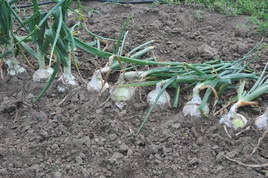
Varieties: If you wish to grow large onions, choose an intermediate type such as Candy, Red Candy Apple or Super Star.
Sets or plants: Though onions can be grown from seed if started inside, we are too late to raise seed-grown plants this year. Therefore, we must grow them from sets or plants. Sets are most often unnamed and will produce smaller onions. Therefore, don’t use sets if the goal is large onions but rather plants of one of the three varieties mentioned above or of another intermediate-day type.
Fertilizing: Onions have shallow root systems and need good, even moisture and adequate fertilizer to develop large bulbs. Fertilize according to soil test and work the fertilizer into the soil before planting. If a soil test hasn’t been done, use a complete, balanced fertilizer such as a 10-10-10 at the rate of 1 pound per 100 square feet. Actually, any fertilizer with the three numbers being similar will work; just follow the directions on the bag to determine how much to use.
Onions respond well to sidedressing (fertilizing a second time) about 3 weeks after the plants have started to grow. Use a fertilizer composed primarily of nitrogen such as nitrate of soda (16-0-0). This fertilizer may be applied at the rate of 2 pounds (about 4 cups) per 100 feet of row. High nitrogen lawn fertilizers such as a 27-3-3, 30-3-4, 29-5-4 or something similar are also good choices, but the rate should be 1 pound (2 cups) per 100 feet of row. Do not use lawn fertilizers that contain weed killers or weed preventers.
Planting: Space plants 4 inches apart to provide adequate room for bulb expansion. Set plants 1 to 1.5 inches deep. Rows can be spaced 12 to 16 inches apart or whatever is convenient.
Care: Keep the onions weeded to reduce competition. Water once per week if no rain. Onions should be ready for harvest around the first half of July. (Ward Upham)
 RSS Feed
RSS Feed
